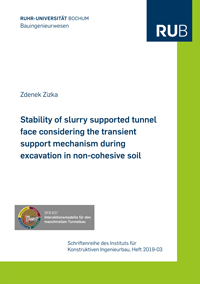
Shop : Details
Shop
Details
49,80 €ISBN 978-3-8440-6940-2Softcover380 pages123 figures566 g21 x 14,8 cmGermanThesis
October 2019
Zdenek Zizka
Stability of slurry supported tunnel face considering the transient support mechanism during excavation in non-cohesive soil
Tunnel face stabilization is one of the three key elements of the soft ground tunnelling. Slurry shields are known to be a reliable excavation method in non-cohesive soils under groundwater level. In such conditions, they can actively support the tunnel face while minimising of the support pressure fluctuations. Two fundamental conditions must be fulfilled to stabilize a tunnel face: A sufficient face support pressure in the excavation chamber and an efficient pressure transfer of slurry excess pressure onto the soil skeleton. At the time of introduction of the slurry shield, the theories to describe the pressure transfer were transferred from diaphragm wall technology, in which the bentonite slurry supports the open trench. In the past, however, increased pore water pressures above the hydrostatic level were measured in front of the tunnel face during excavation. The measurements could not be explained by the pressure transfer theories from diaphragm wall technology. The increased pore pressure significantly reduces the efficiency of the face support. It is expected that the increased pore pressures result from the continuous disturbance of the pressure transfer mechanism by rotating cutting tools at the tunnel face during excavation. The objectives of this thesis are to understand the consequences of simultaneous slurry penetration and tool excavation process at the tunnel face. Further aim is to characterize the pressure transfer and resulting tunnel face support efficiency for various combinations of slurry penetration and excavation scales.
Considering the state of the art of slurry face support and of face stability assessment, two hypotheses about the pressure transfer during slurry shield excavation resulting from the interaction between cutting tools and pressure transfer mechanism are formulated. Case A and Case B of the interaction at the tunnel face are introduced based on local comparison between slurry penetration and tool cutting depth. The Case A stands for higher cutting depth than slurry penetration depth, while Case B represents shallower cutting depth than slurry penetration depth. It is concluded that each case requires different approach of characterization due to repeated primary slurry penetration in Case A and slurry re-penetration in Case B. To obtain the basis for the further comparison with slurry penetration scale, the typical relationship between cutting depth of a tool and the timespan between subsequent tool passing was determined from reference excavation projects. Following on this the slurry penetration was investigated experimentally. Time-dependent permeability of soil for slurry and slurry penetration depth were evaluated for the Case A of interaction. In contrast, the focus of the investigation for Case B was set on the distribution and development of pore pressure and effective stress inside and outside of slurry penetrated zone during the slurry penetration. The investigations for both cases were conducted using originally designed column tests. Case B was additionally investigated using the RUB tunnelling device. A transient FE seepage analysis utilizing the experimentally determined transient permeability coefficients for slurry was necessary to determine the pressure transfer in Case A due to mutual cutting tracks interaction. In Case B, slurry stagnation gradient determined in the experiments could be directly transferred to the tunnel face conditions to assess the transfer due to presence of slurry re-penetration.
It is concluded that the pressure transfer efficiency in Case A is significantly reduced due to increased pore water pressures outside of slurry penetrated zone during excavation. The methods originating from diaphragm wall technology to predict pressure transfer are not valid in Case A. Based on the obtained results, it is recommended to conduct the excavation with a type of interaction according to Case B. Finally, an integrated approach for the design of minimal required slurry pressure to stabilize the tunnel face is suggested.
Considering the state of the art of slurry face support and of face stability assessment, two hypotheses about the pressure transfer during slurry shield excavation resulting from the interaction between cutting tools and pressure transfer mechanism are formulated. Case A and Case B of the interaction at the tunnel face are introduced based on local comparison between slurry penetration and tool cutting depth. The Case A stands for higher cutting depth than slurry penetration depth, while Case B represents shallower cutting depth than slurry penetration depth. It is concluded that each case requires different approach of characterization due to repeated primary slurry penetration in Case A and slurry re-penetration in Case B. To obtain the basis for the further comparison with slurry penetration scale, the typical relationship between cutting depth of a tool and the timespan between subsequent tool passing was determined from reference excavation projects. Following on this the slurry penetration was investigated experimentally. Time-dependent permeability of soil for slurry and slurry penetration depth were evaluated for the Case A of interaction. In contrast, the focus of the investigation for Case B was set on the distribution and development of pore pressure and effective stress inside and outside of slurry penetrated zone during the slurry penetration. The investigations for both cases were conducted using originally designed column tests. Case B was additionally investigated using the RUB tunnelling device. A transient FE seepage analysis utilizing the experimentally determined transient permeability coefficients for slurry was necessary to determine the pressure transfer in Case A due to mutual cutting tracks interaction. In Case B, slurry stagnation gradient determined in the experiments could be directly transferred to the tunnel face conditions to assess the transfer due to presence of slurry re-penetration.
It is concluded that the pressure transfer efficiency in Case A is significantly reduced due to increased pore water pressures outside of slurry penetrated zone during excavation. The methods originating from diaphragm wall technology to predict pressure transfer are not valid in Case A. Based on the obtained results, it is recommended to conduct the excavation with a type of interaction according to Case B. Finally, an integrated approach for the design of minimal required slurry pressure to stabilize the tunnel face is suggested.
Keywords: tunnel face; bentonite slurry; support pressure; slurry shield
Schriftenreihe des Instituts für Konstruktiven Ingenieurbau
Edited by Prof. Dr.-Ing. R. Breitenbücher, Prof. Dr.-Ing. Rüdiger Höffer, Univ.-Prof. Dr. Markus Knobloch, Univ.-Prof. Dr.-Ing. habil. Peter Mark and Prof. Dr.-Ing. Markus Thewes, Bochum
Volume 2019,3
Available online documents for this title
You need Adobe Reader, to view these files. Here you will find a little help and information for downloading the PDF files.
Please note that the online documents cannot be printed or edited.
Please also see further information at: Help and Information.
Please also see further information at: Help and Information.
| Document |  | Document | ||
| Type |  | |||
| Costs |  | 37,35 € | ||
| Action |  | Purchase in obligation and download the file | ||
| Document |  | Table of contents | ||
| Type |  | |||
| Costs |  | free | ||
| Action |  | Download the file | ||
User settings for registered online customers (online documents)
You can change your address details here and access documents you have already ordered.
User
Not logged in
Export of bibliographic data
Shaker Verlag GmbH
Am Langen Graben 15a
52353 Düren
Germany
Am Langen Graben 15a
52353 Düren
Germany
Mon. - Thurs. 8:00 a.m. to 4:00 p.m.
Fri. 8:00 a.m. to 3:00 p.m.
Fri. 8:00 a.m. to 3:00 p.m.
Contact us. We will be happy to help you.



